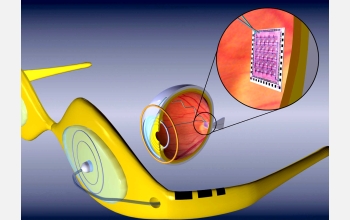Multimedia Gallery
Retinal Prosthetic System
The retinal prosthetic system (illustrated here) consists of an extra-ocular unit and an intra-ocular unit. The first is mounted on a pair of glasses and is responsible for collecting the image by means of a video camera and then transmitting an encoded, digitized image to the intra-ocular unit. The second is composed of a receiving telemetry system, a stimulation current driver and an electrode array to stimulate retinal cells, thus imparting vision perception.
This research was supported by National Science Foundation (NSF) grants BES 98-10914 and BES 98-08040, and was used as the foundation for NSF's new Center for Biomimetic Microelectronic Systems (BMES), headquartered at the University of Sounthern California. The center brings physicians, biologists and engineers together to develop microelectronic systems that interact with living human tissues. The resulting technology will enable implantable/portable devices that can treat presently incurable diseases such as blindness, loss of neuromuscular control, paralysis and the loss of cognitive function.
Credit: Intraocular Prosthesis Group at Johns Hopkins University and North Carolina State University; illustration by Jerry Lim
Images and other media in the National Science Foundation Multimedia Gallery are available for use in print and electronic material by NSF employees, members of the media, university staff, teachers and the general public. All media in the gallery are intended for personal, educational and nonprofit/non-commercial use only.
Images credited to the National Science Foundation, a federal agency, are in the public domain. The images were created by employees of the United States Government as part of their official duties or prepared by contractors as "works for hire" for NSF. You may freely use NSF-credited images and, at your discretion, credit NSF with a "Courtesy: National Science Foundation" notation.
Additional information about general usage can be found in Conditions.
Also Available:
Download the high-resolution JPG version of the image. (549 KB)
Use your mouse to right-click (Mac users may need to Ctrl-click) the link above and choose the option that will save the file or target to your computer.

